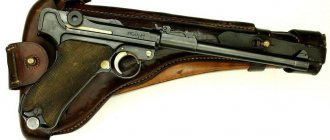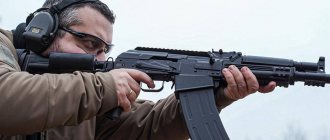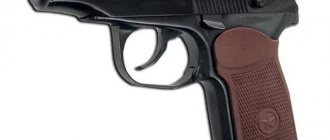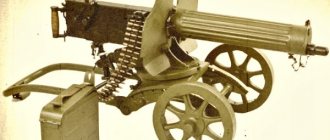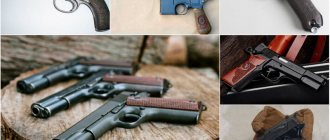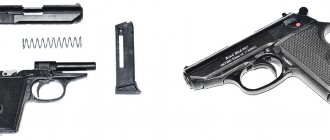The German P08 (or "P'08" or "Luger") pistol was one of the most famous German pistols of World War II. In fact, its origins date back to before the First World War, when the pistol was originally created by Hugo Borchardt.
Only after some time in the life of this weapon the name Luger was reliably attached to it. In these terms, the Luger designation can sometimes be misleading, although it is true to some extent. Serial samples of P08 pistols were developed for the 7.65 mm cartridge caliber and began to be used by the Swiss army by the beginning of the 21st century.
History of the pistol
The first competitive tests for the German army began to take place in the vicinity of Berlin in 1902. Many samples of short-barreled weapons from German and foreign manufacturers took part in these tests.
The state competition lasted quite a long time, until 1904, as a result of which the modified Luger pistol was declared the winner. In 1903, during the tests themselves, the caliber for the P08 was changed from 7.65 mm to 9x19 mm.
This model itself was an improved version of the previous generation of 9 mm pistols, known as "neuerArt". In the same 1903, it was given the name “Parabellum”, which later became the motto of the DWM company.
The word “Parabellum” itself comes from the Latin expression “Si vis pacem, para bellum”, which translates as “If you want peace, prepare for war”, or rather, only the last part of this expression was included in the name - para bellum.
The pistol first entered service with the Kaiser's navy in 1904, and the pistol was introduced into the ground forces of the German Empire in 1908, which is why it acquired the most recognizable name “P08”.
In World War I, the pistol proved to be an accurate and reliable close-quarters weapon, but was very difficult to produce for the German industry of the time.
And between the two world wars, despite the restrictions imposed by the Treaty of Versailles regarding Germany's loss in World War I, the pistol continued to be manufactured either on German soil or at production facilities in other parts of Europe.
The British even released a range of P08 pistols through Vickers-Armstrong and Company, with spare parts supplied from Germany. These versions were eventually sent via Holland to Dutch troops overseas in the East Indies.
By the beginning of the Second World War, despite the complexity of production, the German army already had more than 550 thousand samples of these weapons. The Luger pistol continued to be produced for Wehrmacht units until 1942.
It was subsequently replaced by the new Walther P38. Further production of the P08 and its various modifications were made exclusively for commercial use.
"Parabellum"
The appearance of a pistol called “Parabellum” is associated with September 30, 1899. This is the date when Georg Luger received a patent for a new weapon
. Almost immediately, development of a working model began.
How it all worked
The peculiarity of the pistol's design was that it had a short barrel stroke, corresponding to a system of levers.
In practice the following happened:
- Initially, the levers rigidly fix the bolt.
- The recoil forces the entire lever system to move backwards.
- When the dead center is reached, the arms fold upward.
- This helps unlock the barrel with the bolt moving back.
- The cartridge case is ejected.
- The return spring pushes the formed knee of the levers to its original position.
- The cartridge enters the chamber.
- The bore is locked.
With the advent of the twentieth century, Luger produced several more Parabellum models. But the modification of 1908 under the designation P-08 is gaining the most popularity.
.
This option was adopted by the German army. During World War I, the P-08 became the main pistol of German officers.
There was also the LP-08 model, aimed at artillery crews
. It was also used to arm the junior officers of machine gun teams.
Butt, Leer system
The magazine in this case was standard - 8 rounds, but it became possible to replace it with the Leer disk system, and this is already 32 rounds. Another point is the presence of a holster-butt
, made of wood, which provided an effective range of fire at a distance of about 800 meters.
Design features and main characteristics
The pistol is designed so that the automatic action operates on the principle of using recoil during a short rearward stroke of the barrel.
The channel is locked through a system of articulated levers (crank mechanism), which are in the standard position and in the “dead center” state when fired.
In this position, under the influence of direct pressure from the bolt, the folding of the levers when firing is completely eliminated.
The receiver with barrel is a moving system in which parts of the striking mechanism and the locking mechanism are located. The barrel is connected to the receiver using a special thread.
In the receiver itself there is a moving bolt with an ejector, as well as a striking mechanism.
Design of a single trigger mechanism:
- Trigger;
- Transmission lever;
- Cylindrical striker with striker;
- Mainspring with guide rod;
- Release lever with disconnector.
The last detail is necessary for firing exclusively with single shots.
disassembled parabelum
The Luger safety includes the safety lever itself with a flag and the main safety part, which is located on the left side of the frame, in an inclined position.
System[edit]
The automatic operation of the Luger pistol operates on the principle of recoil of the barrel during its short stroke. The barrel bore is locked using a bolt that moves in the longitudinal grooves of the receiver using a crank mechanism. View of the “knee joint” bolt (animated luger sequence) (German: Kniegelenk)
Receiver from a Luger carbine. The bracket for attaching the forend is visible, which is necessary since the barrel moves in the receiver.
The bolt has a firing mechanism, which consists of a firing pin, a mainspring and a guide rod. The firing pin is cocked when the bolt is rolled back by the interaction of the protrusions of the connecting rod and the firing pin. The pistol barrel is made with a receiver with a threaded one-piece connection. The bolt is moved along the receiver by a connecting rod connected to a crank rotating approximately 90 degrees. When the barrel and bolt roll back together, the crank mechanism is moved out of the “dead center” position by the side protrusions of the frame, acting on the cylindrical protrusions of the crank at the point of its movable connection with the connecting rod. The crank begins to rotate and sends the bolt to its rearmost position. The system returns to its original position using a return spring.
The Luger pistol used a 7.65 mm Borchardt cartridge with a bottle casing shortened by 5 mm. With this cartridge (7.65 mm Parabellum), the pistol was adopted by the Swiss army that year, and at the end of the year it was adopted by the German navy, and the army was armed with it in 1908. The trigger mechanism is equipped with a disconnector, which allows only single fire. The pistol has a safety lever that locks the sear and stops the receiver from moving backwards. Model G has an automatic safety switch that turns off when you put your hand around the handle. The pistol's magazine is box-shaped, designed for 8 rounds, single-row. The Luger pistol is distinguished by an unusually large (compared to modern pistols) tilt of the handle at an angle of 120°. This facilitates accurate shots, but has a negative impact on the operation of the store. In general, the Lugers were distinguished by a fairly comfortable handle, which provided a comfortable grip and comfortable aiming. At the same time, they were complex, as a result, expensive to manufacture and quite sensitive to dirt.
Used cartridgeedit
| Cartridge | Option | Caliber | Initial bullet speed | Kinetic energy of a bullet | Bullet weight | Powder charge weight | Chuck length | Case length |
| 7.65×21 mm | M.1900 | 7,65 | 370 m/s. | 410 J | 4.73 g | 6.7 g | 29-85 mm | 21.59 mm |
| 9×19 mm Parabellum | M.1902;M.1904;M1908 | 9×19 mm | 300-580 m/s. | 380-700 J | 2.9 g | 0.32-0.36 g | 29.70 mm | 19.15 mm |
Performance characteristics and brief information
| Type | Semi-automatic pistol |
| Place of origin | German Empire |
| Service history | German Empire (1904-1918) Weimar Republic (1919-1933) Nazi Germany (1933-1945) Switzerland (1900-early 1970s) Other countries (1900 to present) |
| Used | World War I Spanish Civil War World War II Second Sino-Japanese War Indonesian National Revolution Chinese Civil War Korean War (limited use) Vietnam War (limited use) |
| Developer | Georg J. Lueger |
| Designed | 1898 |
| Manufacturer | Deutsche Waffenund Munitionsfabriken |
| Years of production | 1900-1942 |
| Total produced | 2,800,000 (P08) 285,000 (mod.1900) |
| Weight | 871 g |
| Length | 222 mm |
| Barrel length | 120 mm |
| Caliber | 7.65 × 21 mm Parabellum 9 × 19 mm Parabellum |
| Initial bullet speed | 350-400 m/s |
| Effective firing range | 350-400 m/s 50 m |
| Magazine capacity | 8 and 32 rounds on drum magazine |
Features of various modifications of Luger
Third model
The first prototype of the P08, known as Versuchsmodelle III, which translated from German means experimental model 3, was tested by the Swiss army in 1898.
During testing, it was criticized by the Swiss commission due to excessive weight and an unbalanced center of gravity, which did not contribute to comfort during combat operations.
After this verdict, Luger returned to Berlin with the goal of remaking the pistol. The main decision of Luger and his company was to change the shape of the cartridge, which would subsequently lead to a transformation of the pistol itself and a reduction in its weight.
Thus, a new cartridge with a caliber of 7.65x21.5 mm was created with a bottle-shaped case; it was shortened by 5 mm compared to the previous version.
Repeated tests of the pistol took place in 1899, and already in 1900 the model was adopted by the Swiss army. The DWM company has entered into a contract for the supply of three thousand units of these small arms.
Pneumatic
The KWC P-08 Luger KMB41D pistol is made almost entirely from metal parts. The magazine is designed for 21 metal balls.
The initial speed of the bullet is 100 meters per second. The modification is equipped with a Blowback recoil simulator system.
Shumovoy
A modification of the ME Luger P-08 pistol was created to perform signal and noise operations. In it, as in the original version, the barrel is locked by a crank mechanism.
The pistol magazine is designed for four blank cartridge cartridges of 9 mm caliber, into which pistons are inserted. When a shot is fired, the cartridge cartridge flies out, creating a noise effect, while sparks or flames and smoke come out of the barrel. The fuse is also taken from the original, it is a flag type.
Characteristics:
| Bullet speed | 100 m/s |
| Energy source | CO2 gas cylinder |
| Material | Metal |
| Ammunition type | Metal balls |
| Recoil | Blowback simulation system |
| Magazine capacity | 21 |
| Caliber | 4.5 mm |
| total length | 220 mm |
| Sight type | Sighting bar and front sight |
| Weight (curb) | 0.840 kg |
Luger artillery
The Lange P08 pistol, or simply "artillery" Luger, was a pistol carbine for use by German Army artillerymen as a sort of early personal defensive weapon. This pistol could fire accurately up to 800 meters.
Its feature was an elongated barrel and butt, and was also sometimes equipped with a drum magazine for 32 rounds. Early release LP08s had micrometric adjustable front and rear sights.
It was also available in various commercial carbine versions with even longer barrels. In total, during the First World War, about 195,000 units of these weapons were produced for the German army.
Captured Lugers were highly prized by Allied soldiers during both World Wars as spoils of war.
However, during World War II, German soldiers knew about this and used Lugers as "bait" for anti-personnel mines or hidden booby traps.
The bomb exploded during an attempt to pick up an allegedly accidentally thrown pistol. This tactic was common enough that it made seasoned Allied soldiers deeply suspicious of the apparently abandoned Luger they had discovered.
Manufacturing technologies
The production of weapons was made from alloy steel with high strength and corrosion resistance. The following techniques were used in production:
- heat treatment and hardening of the main parts - frame, barrel, bolt until the strength required for each element is achieved;
- cementation (carburization) of USM elements and connecting axes. The surface layer was diffusionally saturated with carbon when heated;
- treatment of the surface layer for wear resistance, maintaining the integrity of the cores of parts during bending;
- acid oxidation (rust varnish, rust bluing) - protection against corrosion of models from the First World War using a black oxide rust-like film;
- oxidation - in the interwar period and during World War II, weapons received strength;
- hot phosphating - treating steel parts of Parabellums with a phosphate coating in the 1920s.
"Parabellum" - the legendary German pistol
Interesting! The thickness of the carbon layer was no more than 1 mm. The elements became strong, ductile, and could withstand heavy loads.
Interesting fact
The history of the creation of a self-loading pistol began in 1882, when Hugo Borchardt opened his own office in Budapest. It was then that he met Ludwig Lewe, who showed great interest in the Hungarian arms industry.
In 1890, Borchardt visited his company, where the young designer Georg Luger was already working. Soon after visiting the Lewe factory, Borchardt began work on creating a self-loading pistol.
Having patented a new pistol in 1893, he, according to some sources, tried to place its production at the Liege “Fabric National” and eventually reached an agreement with the Berlin manufacturer Ludwig Lewe.
One of the company's directors decided to make a sample of Borchardt's pistol as an experiment. Work on the new pistol lasted about 18 months. Thus the first commercially viable 7.65 mm semi-automatic pistol, the Borchardt C93, was born.

